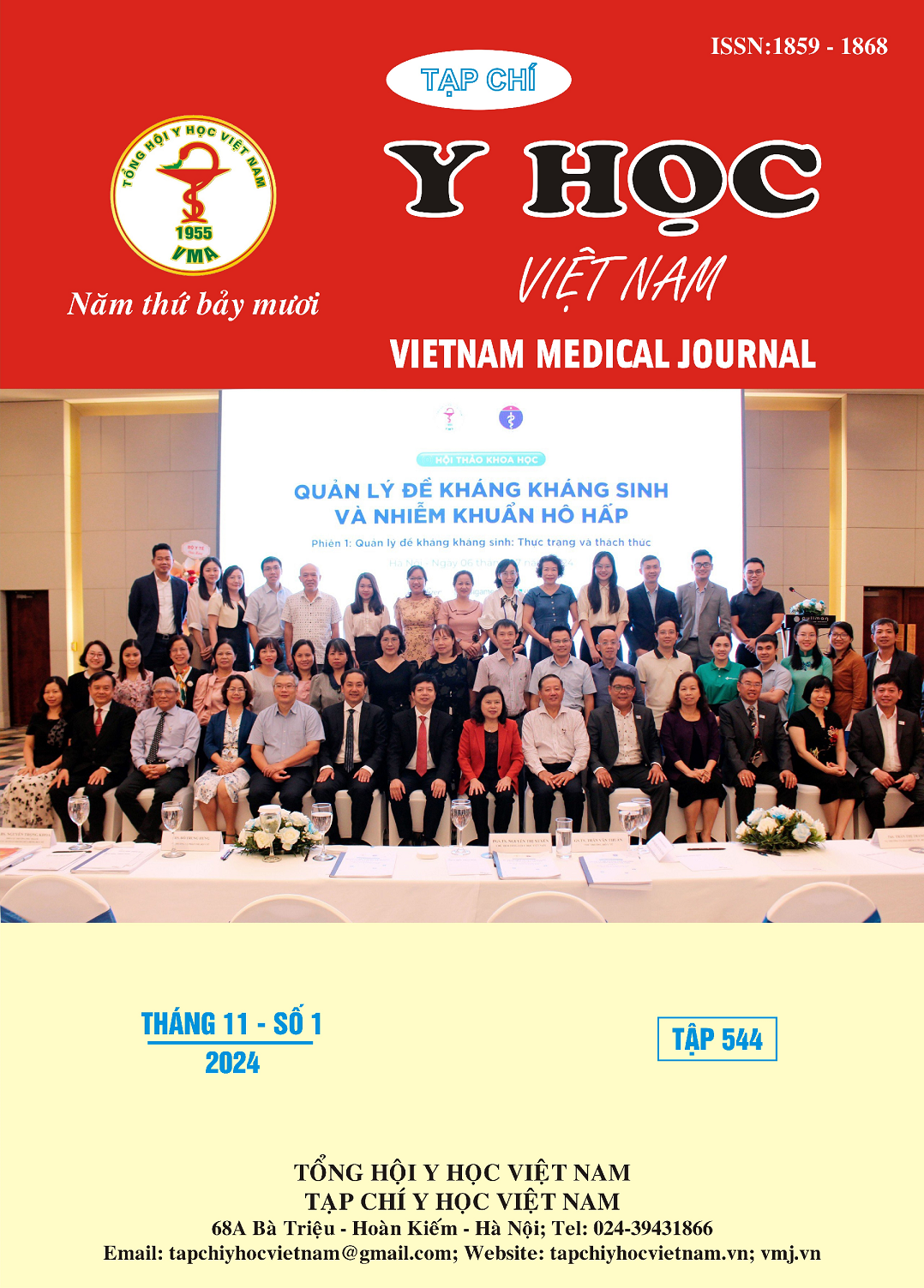KẾT QUẢ PHẪU THUẬT CHUYỂN GÂN THEO PHƯƠNG PHÁP SMITH ĐIỀU TRỊ LIỆT THẦN KINH QUAY CAO
Nội dung chính của bài viết
Tóm tắt
Đặt vấn đề: Liệt thần kinh quay cao không chỉ gây nên tình trạng mất duỗi cổ tay và các ngón tay, đồng thời làm giảm đáng kể lực nắm của bàn tay, ảnh hưởng nghiêm trọng đến chức năng bàn tay. Mục tiêu: Đánh giá kết quả phẫu thuật chuyển gân theo phương pháp Smith điều trị liệt thần kinh quay cao tại Bệnh viện Trung ương Quân đội 108. Đối tượng và phương pháp nghiên cứu: Nghiên cứu mô tả, theo dõi dọc 43 bệnh nhân được phẫu thuật trong khoảng thời gian từ tháng 03/2019 đến hết tháng 03/2024. Thời gian theo dõi trung bình sau phẫu thuật là 37,6 ± 17,9 tháng. Đánh giá kết quả theo tiêu chuẩn Tajima. Kết quả: Nam giới chiếm đa số với 31/43 trường hợp (chiếm 72,1%). Biên độ gấp cổ tay trung bình khi duỗi ngón là 45,840 ± 11,510 và 30,810 ± 11,810 khi gấp ngón. Biên độ duỗi cổ tay trung bình là 32,600 ± 9,950 khi duỗi ngón và 47,850 ± 10,830 khi gấp ngón. 97,7% bệnh nhân duỗi được kết các ngón khi khớp cố tay duỗi trên 100. Biên độ dạng ngón I trung bình là 55,120 ± 3,910. Lực nắm trung bình đạt được là 68,00 ± 6,52% so với bên lành. Phẫu thuật không gây biến dạng nghiêng quay khớp cố tay. 41/43 bệnh nhân hài lòng với kết quả phẫu thuật, 97,7% bệnh nhân tiếp tục trở lại nghề nghiệp cũ. 42 bệnh nhân chiếm tỷ lệ 97,7% đạt kết quả tốt và rất tốt, 2,3% bệnh nhân có kết quả trung bình. Kết luận: Điều trị liệt thần kinh quay cao bằng chuyển gân theo phương pháp Smith đạt kết quả rất tốt. Việc sử dụng cơ sấp tròn làm động lực duỗi cổ tay, cơ gấp cổ tay quay làm động lực duỗi các ngón đạt hiệu quả phục hồi biên độ vận động tốt, tránh biến chứng nghiêng quay khớp cổ tay. Phương pháp này được nhiều tác giả trên thế giới nghiên cứu và khuyến nghị.
Chi tiết bài viết
Từ khóa
liệt thần kinh quay, chuyển gân.
Tài liệu tham khảo
2. Nguyễn Quang Vinh và Mai Trọng Tường (2021), "Điều trị liệt thần kinh quay không hồi phục bằng phương pháp chuyển gân Merle d’Aubigne cải biên", Tạp chí Y học Tp Hồ Chí Minh. 25(2), tr. 80-86.
3. Al-Qattan, M. M. (2012), "Tendon transfer for radial nerve palsy: a single tendon to restore finger extension as well as thumb extension/radial abduction", J Hand Surg Eur Vol. 37(9), pp. 855-62.
4. Altintas, A. A., et al. (2009), "Long-Term Results and the Disabilities of the Arm, Shoulder, and Hand Score Analysis After Modified Brooks and d'Aubigne Tendon Transfer for Radial Nerve Palsy", The Journal of Hand Surgery. 34(3), pp. 474-478.
5. Chung, K. (2019), "Principles and Applications of Tendon Transfers", Grabb and Smith's Plastic Surgery Wolters Kluwer Health.
6. Ishida, O. and Ikuta, Y. (2003), "Analysis of Tsuge's procedure for the treatment of radial nerve paralysis", Hand Surg. 8(1), pp. 17-20.
7. Kruft, S., von Heimburg, D., and Reill, P. (1997), "Treatment of irreversible lesion of the radial nerve by tendon transfer: indication and long-term results of the Merle d'Aubigné procedure", Plast Reconstr Surg. 100(3), pp. 610-6; discussion 617-8.
8. Labosky, D. A. and Waggy, C. A. (1986), "Apparent weakness of median and ulnar motors in radial nerve palsy", J Hand Surg Am. 11(4), pp. 528-33.
9. Reina, Micaela, et al. (2024), "Results of Tendon Transfers in Radial Nerve Palsies: A New Evaluation Protocol", Journal of Personalized Medicine. 14(7), p. 758.
10. Ropars, M., et al. (2006), "Long-term results of tendon transfers in radial and posterior interosseous nerve paralysis", J Hand Surg Br. 31(5), pp. 502-6.


